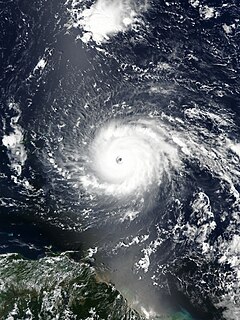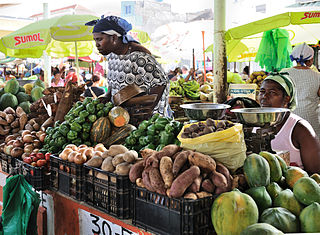
The recorded history of Cape Verde begins with Portuguese discovery in 1456. Possible early references go back around 2000 years.

Praia, is the capital and largest city of Cape Verde, an island nation in the Atlantic Ocean west of Senegal. It lies on the southern coast of Santiago island in the Sotavento Islands group. It is the island's ferry port and is home to one of the nation's four international airports. The city centre is known as Plateau due to its location on a small plateau.

Macaronesia is a collection of four archipelagos in the North Atlantic Ocean off the coast of the continents of Europe and Africa. Each archipelago is made up of a number of Atlantic oceanic islands formed by seamounts on the ocean floor with peaks above the ocean's surface. The Macaronesian islands belong to three countries: Portugal, Spain, and Cape Verde. Politically, the islands belonging to Portugal and Spain are part of the European Union. Geologically, Macaronesia is part of the African Plate, including the Azores, which mark its edge at the meeting point with the Eurasian and American Plates.

A Cape Verde hurricane, or Cabo Verde hurricane is an Atlantic hurricane that originates at low-latitude in the deep tropics from a tropical wave that has passed over or near the Cape Verde islands after exiting the coast of West Africa. The average hurricane season has about two Cape Verde hurricanes, which are often the largest and most intense storms of the season due to having plenty of warm open ocean over which to develop before encountering land or other factors prompting weakening. A good portion of Cape Verde storms are large, and some, such as Hurricane Ivan and Hurricane Irma, have set various records. Most of the longest-lived tropical cyclones in the Atlantic basin are Cape Verde hurricanes. While many move harmlessly out to sea, some move across the Caribbean sea and into the Gulf of Mexico, becoming damaging storms for Caribbean nations, Central America, Mexico, Bermuda, the United States, and occasionally even Canada. Research projects since the 1970s have been launched to understand the formation of these storms.

Fogo is an island in the Sotavento group of Cape Verde. Its population is 35,837 (2015), with an area of 476 km². It reaches the highest altitude of all the islands in Cape Verde, rising to 2,829 metres above sea level at the summit of its active volcano, Pico do Fogo.
The Cape Verde national football team, nicknamed either the Tubarões Azuis or Crioulos (Creoles), is the national team of Cape Verde and is controlled by the Cape Verdean Football Federation.
Cabo Verde Airlines, previously branded TACV Cabo Verde Airlines, is a scheduled, passenger and cargo airline based in Praia, Cape Verde. It is the national flag carrier of Cape Verde, operating flights to Europe, North America and South America. Its main base is Amílcar Cabral International Airport with a smaller one at Praia International Airport. Cabo Verde Airlines is also a ground handling company serving all airports in Cape Verde.

Boa Vista, also written as Boavista, is a desert-like island that belongs to the Cape Verde Islands. At 631.1 km2 (243.7 sq mi), it is the third largest island of the Cape Verde archipelago.

Santiago is the largest island of Cape Verde, its most important agricultural centre and home to half the nation’s population. Part of the Sotavento Islands, it lies between the islands of Maio and Fogo. It was the first of the islands to be settled: the town of Ribeira Grande was founded in 1462. Santiago is home to the nation's capital city of Praia.

The Bay de Verde Peninsula is the largest peninsula that makes up part of the Avalon Peninsula, of the province of Newfoundland and Labrador, Canada. The peninsula separates both Trinity and Conception Bay.

Nelson Mandela International Airport, also known as Praia International Airport, is the airport of Santiago Island in Cape Verde. It was opened in October 2005, replacing the old Francisco Mendes International Airport. It is located about 3 km northeast of the city centre of Praia in the southeastern part of the island of Santiago.
The Catholic Church in the Cape Verde is part of the worldwide Catholic Church, under the spiritual leadership of the Pope in Rome. There are over 430,000 Catholics in the country which represents over 90% of the total population. The country is divided into two dioceses: Mindelo and Santiago de Cabo Verde.

Ilha Verde, also known by its Cantonese name Cing-zau and Mandarin name Qingzhou, is an area in the northwest of Macau Peninsula, Macau that forms part of the Our Lady Fatima Parish. It was an island—known in English as Verde or Green Island—to the west of the Macau Isthmus. It was settled by Jesuits.

Cape Verde is an island nation, part of the Macaronesian group of islands of the Atlantic Ocean and was a former Portuguese colony during the colonial era between 1460 and 1975. EU-Cape Verde relations are founded on the EU/Cape Verde Special Partnership, agreed in 2007, building on six pillars;

Cape Verde is a small archipelagic nation that lacks resources and has experienced severe droughts. Agriculture is made difficult by lack of rain and is restricted to only four islands for most of the year. Most of the nation's GDP comes from the service industry. Cape Verde's economy has been steadily growing since the late 1990s, and it is now officially considered a country of average development, being only the second African country to have achieved such transition, after Botswana in 1994. Cape Verde has significant cooperation with Portugal at every level of the economy, which has led it to link its currency first to the Portuguese escudo and, in 1999, to the euro.

The Palos Verdes Hills are a low mountain range on the southwestern coast of Los Angeles County, California. They sit atop the Palos Verdes Peninsula, a sub-region of the Los Angeles metropolitan area.

Cape Verde was a colony of the Portuguese Empire from the initial settlement of the Cape Verde Islands in 1462 until the independence of Cape Verde in 1975.


















